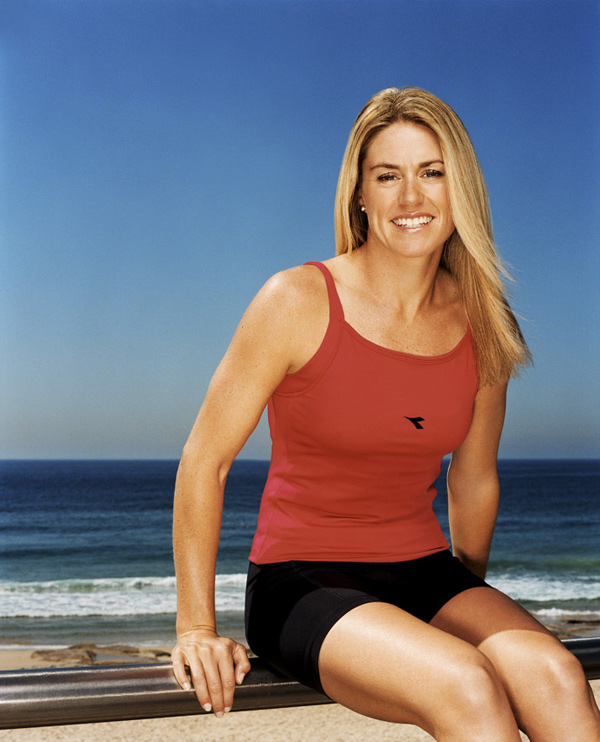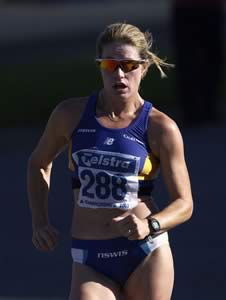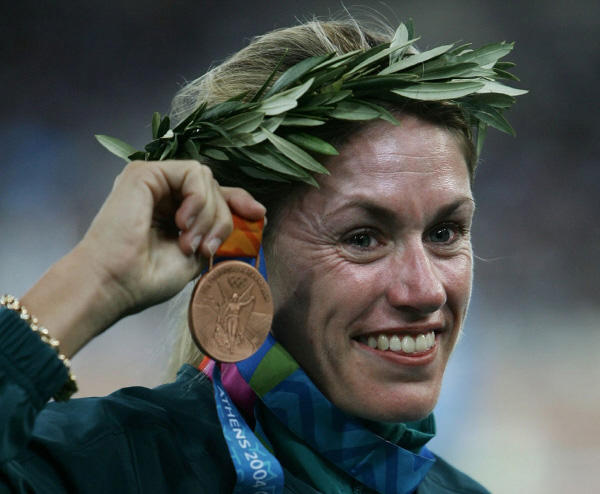| Very often in sport we see the triumphs of athletes at the big events and then they quietly diminish to be replaced with the latest talent. However this was most definitely not the case for Race Walker Jane Saville who sustained a career spanning 20 years; and she even managed time to answer some of our questions at Women’s Sport Report.
Jane participated in every sport as a child, “I started ‘Little Athletes’ at the age of 4, its athletics for kids in Australia and New Zealand.” Jane “loved it, it was like a big social event for me.” The young athlete enjoyed winning relay in the Under 7 event, a sprinting ability that Jane admitted didn’t last long.
Diversity in sport was something Jane maintained into her teens where she combined swimming, surf life saving and athletics. “I believe that they complimented one another in the fact that I was never bored and swimming is a great way to maintain fitness without the pounding on your body; although at times I think (in hindsight) I tried to do too much.” The dream of going to the Olympics hit home when Jane left University at 21 and started to focus on Race Walking as her career.
| |
 | |
|
Race Walking isn’t always the first sport we think of when we consider the Olympics and therefore we under-estimate the physical skill and demands this discipline requires, I asked Jane about this: “People don’t realise how fast race walkers can move and it’s not until they see it live they can truly appreciate the athleticism required to participate in race walking at the elite level. Not only do race walkers need excellent endurance they also need to be strong in the upper body and core to help drive the technique; this is the major difference to runners. Once you understand and learn the technique of race walking you have to maintain your strength and endurance to keep it going for 20km or 50km (for the men). But there is such a difference between running and race walking that race walkers never feel the urge to run because it’s a completely different technique just like butterfly and freestyle.”
In 1998 Jane beat her hero Kerr Saxby-Junna at the Commonwealth Games and from there her confidence grew with a 7th place at the World Championships in 1999 the natural progression was to the Olympics in 2000. With the attitude that “I could do better than the last race” Jane was establishing herself as one of the best in the World.
Sport is a truly unpredictable past time, its what makes us so passionate about it but its unpredictability can also be punishing on the athlete. In Sydney 2000 the script was written for Jane to win Gold on home turf but unfortunately it just wasn’t to be. However she showed her strength in 2004 at Athens by winning an Olympic medal. “It wasn’t really relief but just a huge sense of achievement as I was extremely proud of myself; how I’d overcome the tough times”
| |
 | Race Walking seems to run in the family and in 2006 Jane’s sister Nat finished behind her in silver place, a proud moment?
“It was great to have Nat there with me on the podium and her to achieve her goal as well. It’s not very often that we both achieved our race walking goals at the same competition so it was certainly a huge occasion and I was especially proud for my family, as they were there to share the moment with us. But I think my proudest Commonwealth Games was when I was a surprise winner in 1998; a surprise to everyone including me.” |
|
It is clear to see, just from Jane’s results and her obvious passion for the sport that she is a true athlete, so how do you come to the decision to retire: “I always knew that I was going to retire in either 2008 or push it to 2009; certainly 2008 was going to be my last Olympics. But I had been fighting injuries for a couple of years and it was getting more difficult each year. Also the fact that I wanted to start a family with my husband and I certainly wanted to finish my career before doing that as I personally don’t want my kids following me around the world on training camps and competitions.”
I can only agree with Jane when she says that overcoming the three disqualifications in 2000/2001 and coming back stronger with an improved technique, the mental strength to battle the negativity and the talent to keep winning stood out as one of her best achievements.
Jane is a keen ambassador for healthy living and exercise; she is helping to get this message out to the public. She has recently organised charity runs that took place at the end of February. “The event was only 6km long and all entry fees went to Ian Thorpe’s Fountain for youth Charity. My aim was to encourage healthy, active lifestyles and provide the environment for people to participate in a fun, family event. Hopefully next year I can encourage more people to walk the event as a start to their new active lifestyle. I always say that exercise doesn’t have to be too hard just regular, I just need to get that through to people.”
| |
 | |
| Athletics and sport have so far played a major part in Jane’s life, I wondered if this involvement was set to continue even if she wasn’t on the track herself: “In one way or another for sure. I would like to help the sport of Athletics develop especially in Australia as I see a large decline in participation rates especially at the adolescent level. My husband was a professional cyclist and is now a Director of a professional Cycling Team; Garmin Slipstream in Europe so I’m sure it will be part of both our lives.” | |
Written by Laura Hannan for WSR | |